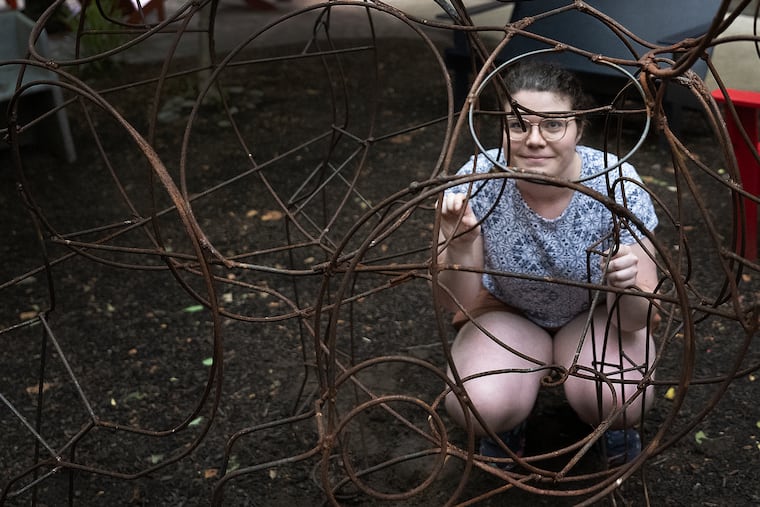As University of the Arts closes, where does the art go? One student just freed her giant, metal goat.
Winding down a 150-year-old art school and figuring out what to do with all of the beautiful, complicated, large, quirky, important things that make up the institution is no small feat.

When Lisa Jo Epstein heard the stunning news that University of the Arts, her daughter’s school, was closing Friday, one of her first thoughts was: “What about the goat?”
Zivia Brown, 22, an illustration major, created a five-foot metal goat sculpture for one of her classes last year, and Brown’s professor liked the work so much that he installed it in a university courtyard, a seemingly permanent move.
“I imagined it being here for years; I imagined coming back as an alum and seeing it,” said Brown.
Closing down a 150-year-old art school and figuring out what to do with all of the beautiful, complicated, large, quirky, important things that make up the institution is no small feat. And to date, answers from administrators have been in short supply; the university’s president resigned shortly after the closure announcement, and a management firm has been brought in to oversee what’s next.
Presumably, the goat was not on anyone’s mind — except Brown’s and Epstein’s.
So, mother and daughter took things into their own hands. Epstein, an artist, teacher and director herself, woke up in the pre-dawn hours of Thursday morning determined to arrive at a plan for extracting Goat, as it is known, and somehow getting it back to her Germantown home.
A neighbor came through with a truck and an offer to drive the pair for the rescue. Epstein gathered tools — hammers, a shovel, “a garden digging thing that’s even more intense than a crowbar.” Who knew how firmly Goat was planted into the ground?
It felt a bit cloak-and-dagger: With closure looming, security is tight. Would they get stopped on their Goat extraction?
But the guard Brown and Epstein encountered was warm and helpful, escorting them into the courtyard of Hamilton Hall, off South Broad Street, offering condolences for the school’s closure. And the pair set to work, with Epstein fondly patting Goat while Brown crouched down, trying to leverage Goat out with the back of a hammer.
The first metal spike popped out of the moist brown dirt easily. The second was not as quick.
“This one’s pretty deep,” Brown told her mother, rocking the hammer back and forth. She spent half a semester on Goat, earning an “A” for her project.
Brown would have been a rising senior, with just her internship and thesis left to complete, had the closure not happened. University of the Arts was not her first college; she started during the pandemic, at Pratt Institute in New York, before transferring to UArts. Now, she’s looking at needing to transfer to a third college, likely Moore College of Art and Design, she said.
“It’s been a pretty bumpy college ride so far,” said Brown, who is interested both in children’s book illustration and board game design. She would have had to complete only three more classes before graduation had University of the Arts not closed, but will likely have to take four at Moore.
The third spike was finally unearthed, it was time for the next phase of Goat Rescue. Epstein tried to put aside her emotion.
“It’s been a real honor to have her art in this courtyard,” Epstein said. “We thought it would be in perpetuity. It filled us with joy and pride. And just it’s really sad.”
Mother and daughter lifted the sculpture, 50 pounds or more, and maneuvered it through the courtyard to their neighbor’s waiting truck. The next phase of the operation? Onto the truck bed and out of Center City, a bittersweet move.
“We have a little tiny garden,” Brown said. “We’ll fit it in somehow.”